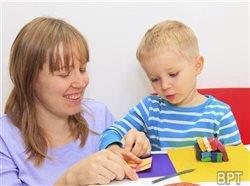Creating connections with children who have Autism
(BPT) - It’s the single most-common developmental disability in America, affects more than 2 million Americans, has grown 10-fold in the past four decades, and is a highly complex disorder, yet at its heart Autism is a disorder that affects human interactions.
Autism spectrum disorder (ASD) and autism are generally described as complex brain development disorders characterized by difficulties in social interaction as well as verbal and nonverbal communication. In other words, autism is a complex developmental disability which usually becomes apparent during the first three years of a person's life. And following the February 2014 publication by the Journal of Autism and Developmental Disorders of the DSM-5 diagnostic manual, all autism disorders (including Asperger syndrome) were merged into one umbrella diagnosis of ASD.
One in 68 American children are diagnosed with some form of autism, making it the most common developmental disability in the United States, according to Autism Speaks, one of the largest autism advocacy organizations. ASD affects more than 2 million individuals in the U.S., which represents a ten-fold increase over the last 40 years. While research shows that this increase is partly explained by improved diagnosis, the growing awareness puts additional emphasis on one of the biggest concerns. How can friends and family members of autistic individuals improve their relationship and better connect through autism?
“Autism is something that affects families for the rest of their life. It became the steering wheel of our family’s life,” says David Royko, a licensed clinical psychologist and father of twin sons – one being severely autistic.
Royko says that autism is a “peculiar” disorder in the sense that some diagnosed individuals nurture and embrace the “distinguishing characteristics,” but more commonly it is the goal to make the autistic individual’s life as comfortable as possible.
While there is currently no cure for autism, or even a clear cause, numerous forms of treatment are available, and range from biomedical to residential housing. Royko says that while residential housing helps his son and his family live more comfortably, this particular area of treatment is a battlefield of legislation. Rules that restrict individuals from receiving the specialized care they need could threaten his son’s development as well as the growing population of autistic adults in the United States.
Dr. Lianne Koki, a licensed clinical psychologist and associate professor at the Hawaii School of Professional Psychology at Argosy University, believes that bodies adapt to the environment. “If the environment is comfortable, then the autistic individual will find the relationship rewarding, thus making social behavior rewarding through building relationships,” says Koki, who is also a mother of two autistic children and a specialist in the field of autism. “The more rewarding feelings that are ignited by relationships, the more relational an autistic individual may become,” adds Koki.
Not all individuals with autism require the same environment. Community living is a new form of treatment that is being researched and tested. Special environments are developed, ones that enforce positive relationships and are aimed at meeting the specific needs of autistic adults. One example is Bittersweet Farms in Whitehouse, Ohio. There, autistic adults, along with the help of a caregiving staff, run the farm, keeping busy and creating positive social interactions.
Intervention programs are another way to build a strong relationship between autistic individuals and their families, caregivers and therapists. In fact, it may be crucial in the development of an autistic individual. Some people, such as a caregiver, may become better connected and form constructive relationships through autism. “Autism forces the caregiver to slow down and understand the other person a little better ... it allows them to appreciate who the individual is and how they engage in their world and with other people,” says Koki.
Both Koki and Royko stress the value of a positive social environment, which is beneficial to the development of autistic individuals. A positive environment can help form a lasting connection and will benefit those around the autistic individual as well.
Unfortunately for a lot of people, autism may still be confounding. It's difficult to determine why it happens, it manifests itself differently in each person, and it's hard to treat. There may not be a cookie-cutter solution to better connect with your loved one, but it's a disorder about interaction, and that means there is always room for improvement.























